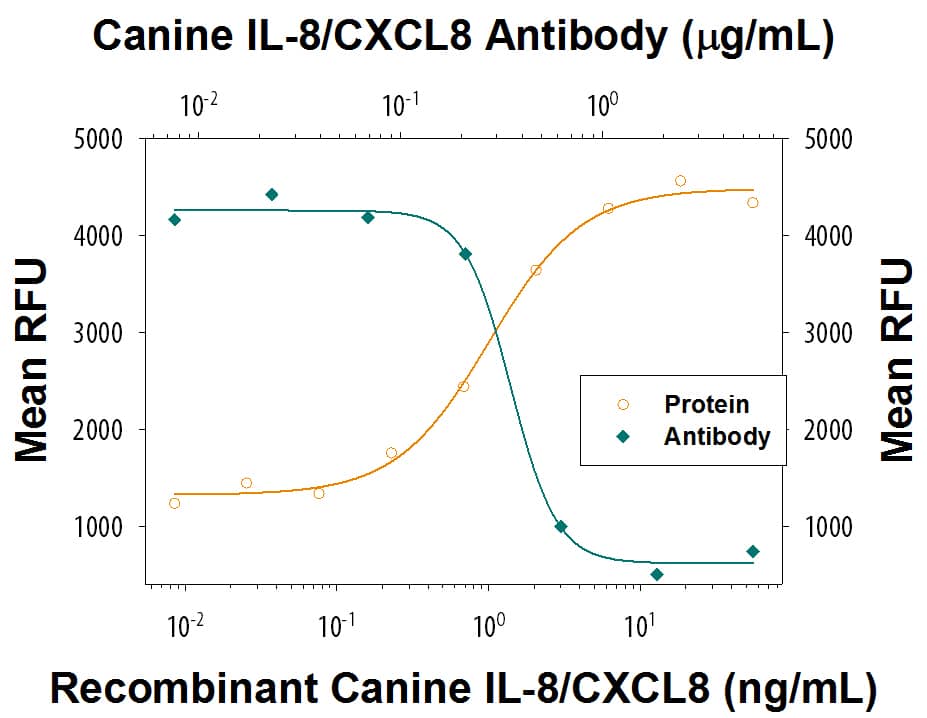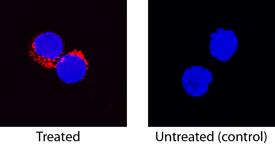Canine IL-8/CXCL8 Antibody
R&D Systems, part of Bio-Techne | Catalog # AF1608


Key Product Details
Validated by
Species Reactivity
Applications
Label
Antibody Source
Product Specifications
Immunogen
Ala23-Pro101 & & Val28-Pro101
Accession # P41324
Specificity
Clonality
Host
Isotype
Endotoxin Level
Scientific Data Images for Canine IL-8/CXCL8 Antibody
Chemotaxis Induced by IL-8/CXCL8 and Neutralization by Canine IL-8/CXCL8 Antibody.
Recombinant Canine IL-8/CXCL8 (Catalog # 1608-CL) chemoattracts the BaF3 mouse pro-B cell line transfected with human CXCR2 in a dose-dependent manner (orange line). The amount of cells that migrated through to the lower chemotaxis chamber was measured by Resazurin (Catalog # AR002). Chemotaxis elicited by Recombinant Canine IL-8/CXCL8 (10 ng/mL) is neutralized (green line) by increasing concentrations of Goat Anti-Canine IL-8/CXCL8 Antigen Affinity-purified Polyclonal Antibody (Catalog # AF1608). The ND50 is typically 0.1-0.5 µg/mL.IL-8/CXCL8 in Canine PBMCs.
IL-8/CXCL8 was detected in immersion fixed canine peripheral blood mononuclear cells (PBMCs) treated with Concanavalin A using Goat Anti-Canine IL-8/CXCL8 Antigen Affinity-purified Polyclonal Antibody (Catalog # AF1608) at 15 µg/mL for 3 hours at room temperature. Cells were stained using the NorthernLights™ 557-conjugated Anti-Goat IgG Secondary Antibody (red; Catalog # NL001) and counterstained with DAPI (blue). Specific staining was localized to cytoplasm. View our protocol for Fluorescent ICC Staining of Non-adherent Cells.Applications for Canine IL-8/CXCL8 Antibody
Immunocytochemistry
Sample: Immersion fixed canine peripheral blood mononuclear cells treated with Concanavalin A
Western Blot
Sample: Recombinant Canine IL-8/CXCL8 (Catalog # 1608-CL)
Neutralization
Formulation, Preparation, and Storage
Purification
Reconstitution
Formulation
Shipping
Stability & Storage
- 12 months from date of receipt, -20 to -70 °C as supplied.
- 1 month, 2 to 8 °C under sterile conditions after reconstitution.
- 6 months, -20 to -70 °C under sterile conditions after reconstitution.
Background: IL-8/CXCL8
Interleukin 8 (IL-8), also named monocyte-derived neutrophil chemotactic factor (MDNCF), neutrophil-activating protein 1 (NAP-1), neutrophil-activating factor (NAF) and granulocyte chemotactic peptide (GCP), belongs to the Glu-Leu-Arg motif containing (ELR+) CXC chemokine family and has been designated CXCL8. IL-8 is a potent neutrophil chemoattractant that recruits neutrophils to sites of inflammation. IL-8 also activates neutrophil functions and through a poorly understood mechanism, promotes angiogenesis. The biological activites of IL-8 is mediated by two types of G protein-coupled chemokine receptors, CXCR1 and CXCR2. In normal tissues, IL-8 expression and secretion is barely detectable. Upon stimulation by a wide range of pro-inflammatory signals including exposure to IL-1, TNF, bacterial or viral products, IL-8 production is rapidly induced in many different cell types. Secreted IL-8 is not glycosylated but has N‑terminal sequence heterogenecity due to proteolytic processing. In human, two major forms, the 72 amino acid (aa) monocyte-derived IL-8 and the 77 aa endothelial IL-8 have been identified. Whereas the 72 aa isoform is a more potent chemoattractant, only the 77 aa isoform can induce apoptosis in leukemic cells. The N‑terminal pentapeptide in the 77 aa isoform has been identified as the active site for the IL-8 apoptotic activity. Canine IL-8 encodes a 101 aa precursor protein with a putative 22 aa signal peptide. It shares 77% and 87% aa sequence identity with human and porcine IL-8, respectively. Similar to human IL-8, recombinant canine IL-8 also undergoes
N‑terminal processing. Two major peptides (the 79 aa and 74 aa variants that differ by an analogous N‑terminal pentapeptide) are present in the recombinant canine IL-8 preparations.
References
- Van Damme, J. et al. (1998) in The Cytokine Handbook, A.W. Thomson, ed., Academic Press, New York., p. 271.
- Terui, Y. et al. (1998) Blood, 92:2672.
- Terui, Y. et al. (1999) Cancer Research 59:5651.
Long Name
Alternate Names
Gene Symbol
UniProt
Additional IL-8/CXCL8 Products
Product Documents for Canine IL-8/CXCL8 Antibody
Product Specific Notices for Canine IL-8/CXCL8 Antibody
For research use only
